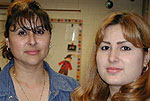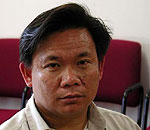By Laurel Druley
Minnesota Public Radio
September 23, 2002
Children of immigrants often have trouble fitting into North American culture. Language is at the heart of the problem. Some children of immigrants reject their native language and culture in hopes of fitting in. Parents are concerned that different generations in the family may not be able to speak to each other. They are left with a balancing act of preserving language, while joining the American melting pot.
| |
|
|
|
||
About 20 children bubbling with energy gather in a brightly decorated classroom at the end of the school day. Spanish and English words fly around the room. A couple adult volunteers try to give instructions in Spanish.
This is Owatonna's Club Latino, an after school program for children in grades 1-8. It's a place where children gather once a week to be reminded of their roots. They make pinatas and other crafts, eat Mexican food and play games that help them practice their Spanish.
Consuelo Contreras, who helps organize the group, has a 10-year old daughter. Speaking through a translator, she says her daughter did not want to speak Spanish with her in school.
"She felt embarrassed that other people could hear her speaking another language. It's really difficult to bring a child to another country speaking a foreign language."
Contreras says many times when immigrant children first arrive in the United States, their self esteem suffers along with their grades. She's seen a positive change in her daughter since Club Latino started.
Claudia Silva Rodriguez, 17, is a teen leader with Club Latino. She moved to Owatonna two years ago from Mexico with her immediate family. She says life was really difficult here initially. Speaking through a translator, she says at school she met a few teenagers who have forgotten or rejected their first language.
| |
|
|
|
||
"I say 'hola.' They say 'hi.' I ask, 'Do you speak Spanish?' They say, 'No.' They speak only English but they're Latinos. It's bad," says Rodriguez.
Rodriguez says she's proud to be Mexican-American.
Judy Auger, ESOL program coordinator for Rochester Public Schools, says it's more difficult for immigrants who come to the U.S. as teenagers.
"They want desperately to fit into this culture," Auger says. "And fitting into this culture means wearing what other students wear. Perhaps that means participating in activities. If they want to fit in, sometimes that means rejecting everything about their own culture."
She says last year there were 58 different languages spoken in the Rochester schools -- too many for the schools to offer bilingual programs. Auger encourages parents to speak the first language to their children at home.
This issue is nothing new.
Every immigrant group throughout U.S. history has had to struggle to find a balance between maintaining culture and fitting in.
| |
|
|
|
||
In the late 1800s, it was the Norwegians. Kathleen Stokker, Norwegian professor at Luther College in Decorah, says when Norwegians first started coming to Minnesota, Norway was overpopulated and Norwegians wanted to give their children a better life. But the generation gap between children and parents became a cultural gap as well.
"Children view the customs and world view and values of the parent generation - which they identify as very old country - as something to almost be ashamed of because it doesn't fit in," Stokker says.
She says her parents never taught her Norwegian because it was important to be a part of the melting pot.
"Teddy Roosevelt said, 'There is no room in America for hyphenated Americans. We are all either Americans or we are not Americans,'" Stokker says.
"And this put just a terrible chill into the continuation of any kind of ethnic identification. Parents came to feel very strongly that they would be doing their children a disservice by continuing to teach them the language."
Stokker says history has repeated itself. Getting in touch with roots has become a popular pastime. But she says the recent flag-waving in the United States has been reminiscent of the nationalism felt during World War I.
| |
|
|
|
||
Tensions introduced by Sept. 11 led to intolerance of minorities. For many immigrants, fitting in has been more challenging than ever.
Some of the recent waves of immigrants - Latino, Hmong, Somali, Bosnian and Thai - have succeeded in protecting their cultural identity through groups like Club Latino. But for smaller communities, it's up to the parents.
Sarun Prum, a Cambodian refugee, moved to Rochester and started a family several years ago. His three children speak English at home, but Prum speaks to them in Khmer.
It's important for Prum that his children communicate with their grandparents in Cambodia. Prum's oldest daughter is 15. He says it wasn't until her junior high teacher showed her class the movie The Killing Fields that she became interested in her heritage.
"She asked me, 'Is it where you come from?'" Prum recalls. "It was a very good tool. Her teacher ask her to interview me so she had to learn from me. She must do her homework. If sitting at the table and I was telling story of Cambodia (sic), maybe she doesn't want to listen."
Prum told her about what life was like when he was her age.
"The war started 1968 in our hometown, so we started running from place to place from war at the age of 9," he says. "So I lost that age. I told them that. I say you have a lot. I miss a lot of what you have right now."
The Cambodian government is still unstable, but Prum says the killing has stopped. He says once his children are fine on their own he'll return to Cambodia.
Some youngsters see advantages to being bilingual.
In Owatonna, 9-year-old Stephanie Ortiz looks forward to Club Latino each week. Ortiz was born in the United States but her parents are from Mexico. She speaks Spanish at home and English at school.
"People say its a very good thing when you know two languages," Ortiz says. "And you'll get a good job when you grow up. You're lucky and stuff. And people ask me, 'How do you say this?' 'How do you say that?' It's pretty cool."
Ortiz says she's been translating for some of her classmates since the first grade. And she says that's pretty cool, too.
More from MPR



